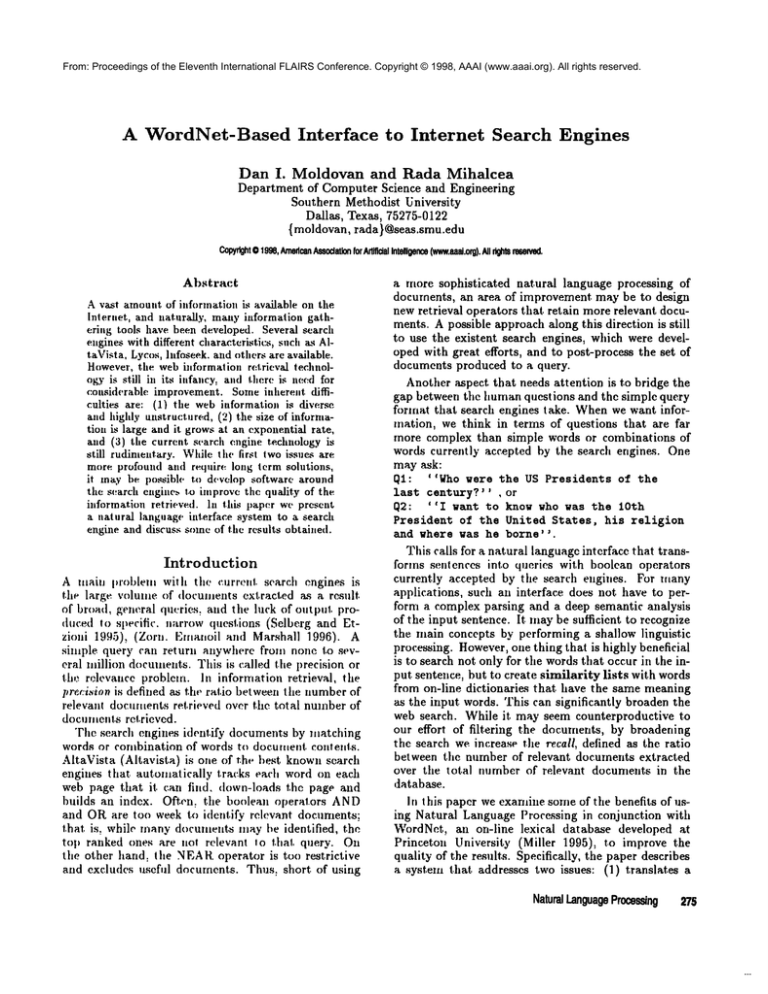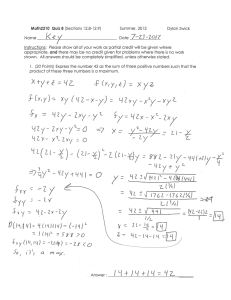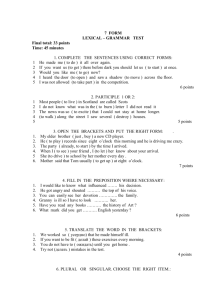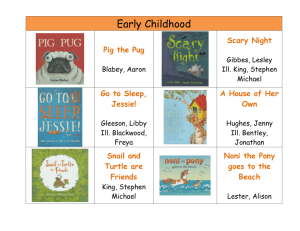
From: Proceedings of the Eleventh International FLAIRS Conference. Copyright © 1998, AAAI (www.aaai.org). All rights reserved.
A WordNet-Based Interface
to Internet
Search Engines
Dan I. Moldovan
and Rada Mihalcea
Department of ComputerScience and Engineering
Southern Methodist University
Dallas,
Texas,75275-0122
{ mo]dovan,
rada}@seas.smu.edu
Copyright
¯ 1998,
Amodcan
Association
forArtificial
Intelligence
(www.eaaJ.org).
Allrights
reun~l.
Abstract
A vast amountof inh~rmationis available on the
Internet, and naturally, manyinformation gathering tools have been developed. Several search
engineswith different characteristics, sucll as AItaVista, Lycos,]nfoseek.and otlners are available.
However.tlm webinformation rel.rieval technologyis still in its infancy, and there is needfor
cousiderable improvement.Someinhere.t difficulties are: (1) tile webi.formation is diw’.rse
a.d highly unstruet.red, (2) the size of informatio,t is large and it growsat an exponential rate.
a,,d (3) the current search engine tech,tology
still rudime,,tary. Whilethe first twoissues are
more profound and require long term solutions,
it maybe possible to develop software around
tile search e,tgi.e.- to improvetim quality of the
il,formation retrieved. In this paper we present
a natural language iaterface system to a search
e,zgine and discuss someof tile results obtai,,ed.
Introduction
A main I~rol.,lenn with the curv’,,t,1, search engines is
the large~ wdumeof documents extracted as a result
of broad, general queries: and the luck of outpul, produced to specific, narrow quesl.ions (Selberg and Etzioni 1995), (Zorn. Emat,oil and Marshall 1996).
si,nplequerycanreturnanywhere
fromnoneto several,,illion
docuntent.s.
Thisiscalled
theprecision
or
t.[,.’,
relevance
problct,t.
Ininformation
retrieval,
/lle
precision is defined as theratio between the number of
relevant documents retrieved over the total number of
documents retrieved.
The search engines ich, nt.i~’ clocuments by matching
words or combination of words to docu,,ent contents.
AltaVista (Altavista) is one of the best knownsearch
engines that automatically tracks each word on each
web page that it. can find. down-loads the page and
builds all index. Often, the boolean operators AND
and ORare too week to identi~’ relevant documents;
that is, while many documents may be identified, the
top ranked ones are itot relevant to l.hat query. On
tl,e other hand: the NEAR.operator is too restrictive
and excludes useful documents. Thus. short of using
a more sophisticated natural language processing of
documents, an area of improvement may be to design
new retrieval operators that retain more relevant documents. A possible approach along this direction is still
to use the existent search engines, which were developed with great efforts, and to post-process the set of
documents produced to a query.
Another aspect that needs attention is to bridge the
gap between the humanquestions and the simple query
h)rmat that search engines take. Whenwe want information, we think in terms of questions that are far
more complex than simple words or combinations of
words currently accepted by the searcl, er, gine.s. One
may ask:
~I: ’’Who were the US Presidentsof the
lastcentury?’
~ , or
q2: ’’I want to know who was the lOth
Presidentof the UnitedStates,his religion
~’
and where was he borne
This calls for a natural languageintcrface that transforms sentences into queries with boolean operators
currently accepted by the search engines. For many
applications, such an interface does not have to perform a complex parsing and a deep semantic analysis
of the input sentence. It maybe sufficient to recognize
the main concepts by performing a shallow linguistic
processing. However,one thing that is highly beneficial
is to search not only for the words tlnat occur in the input sentence, but to create similarity lists with words
from on-line dictionarie.~ that. have the same meaning
as the input words. This can significantly broaden the
web search. While it may seem counterproductive to
our effort of filtering the documents, by broadening
the search we increase the recall, defined as the ratio
between thc number of relevant documents extracted
over the total nurnber of relevant documents in the
database.
In this paper we exan,ine some of the benefits of using Natural Language Processing in conjunction with
WordNet, an on-line lexicai database developed at
Princeton University (Miller 1995), to improve the
quality of the results. Specifically, the paper describes
a system that addresses two issues: (1) translates
NaturalLanguage
Processing
275
i
W¢,r’-#,N
cl
,,--,,,-;;;,::;:
-t-/......
L i
I
..... I
~h~lu~
h
.
q,
.............
T
r¢liill,~t’l.~’d by"1~.11
.,~,~5I,.xi,’¢,-.~,’lli;llll i,’ r,.l’il i,,ll,~,IIl’lk-.
ilil~ \~l’~i’,lN,’l :’~ iL.~,’fill I’t’.~tllLL’,’,’ I’,,1" IL:II.ILL’;il I:lll~,il’l~l"
I,i ’, W,’~SSilig.
I:l,r ~.XaiLild,’. tIV,,i’,l\t’L
li-l.Ihv r,~li,’,.I,t
{cat,
true cat} wivh i.h,.
~41,,.~:
Ifeline
mammalusually
having thick soft fur and being unable to
roar; domestic cats; wildcats). Frt,m ~,ur w,,ri,[
,,Xl,,~rietice. w,.’ v’~’;iliz,’
I.hal Ihi.~ d,,linilic~n d,,,’~ lil,t
r’(,vt.r fill w(’ ~111)%1; ;llll;ill.
,’at.c,. W(~i’,IN,,I. pL’i>vid,’.~ :lddhional hll’oriiial.irlli
.ll,,>iit
Ih,. C,UlCr’l,l. tcat, true
cat)byii,~ h.vl,i’l’lL)’ILi(’~ ,ltL,I ih~’h’ .141i,.~.~¢’s ;lind al.’.’,~
liy l.h,. glcJ~,..~ or oll,.r <’,,li,.,.lit.~
llliil
ilS,, /cat, true
catI m~;i d,’lhiilii4 ,’l,nr(’l,I.
I’]xililillh’s
,d" v.h,.~,’ ;il’(’;
{mouser}. gh,s.~: (a cat proficient
at mousing)
{meow, mew,miaou,
miaow}.gl,~ss:
(the sound made
by a cat)
Icaterwaul}.~h~,~s: (the yowling sound made by a
cat in heat)
{pur}, gl,~.~,~:
(a low vibrating sound typical of
a contented cati.
Ill ~Voi.d.Nl,I tile" r’iflLLl’l’]ll
{cat, true cat} is I’,’l;ll,’d
ttl ’;lFI ,JilLt’l" <’tlLl,’~’l,ls {lii fl’i,liL ins IthL~s.:l,~ I’l’tliLi 11.’
glll,’4.~,’S
IJf its ]LVIii’I’LLylLL~.
7,’i "lille’S’illS
thai IIN, il ill
rh,,ir gl~,,~.~esa.~ a dvlhLhil4 ,’l,liW’lll
I,lii.~ 1.12 ,’,,Lir~.pl.~
with whi<’hlh,’ ,’~llirl.lll
ilil,’l’;l<’i.~
iLl vhv~,.")~’l iAlt,.~.~,’.~).
’l’hi.~ hiforiLialiflii is ...,’iiiilLilirillI.v
v’irh ,.il,,iL~h I.,, i,r,’.’qLIIn," Ihal li~"or,IN,’l. ,’fiLl .i<’l ~i.~ ,i. I,,,wl’rl’iLI kL.,wl,,l~;<’
I+;i,~,. for iILrCiI’ILlali,,li ,’xl I’;t<’l i()li.
~rord-sense
disambiguatlon
(}urid,.a I;~rword
.~,.ws,.,lisai,ibi~.aii,,li i.~ i,, ..~,’ W,,r,I-
This LLifllhllt’ hasI),’l’ii
,Id,q~led ri’i’llLi
ali iilrl,rliial.i¢~li
i,Xll-a¢l.[oli
sy~I."iLL d,~v,qolIPd
by LI~ tbP the M If(’ coinllOl.ilioli
(M¢llli~>vaii i.f a]. 19¢.13). Ph’si il,. ~,’ili.l’iLrv
b¢lundarie,~ ;il-i. hw;tl~’d. I1 ItL,’iL IdaC,’.~ pari or sp,:,.rh
l.als Oil woi’d~by IlSillt3, a. Vt’l’.’4iOli i,f l.h’ill’.~ l’l g~
,,<~(r lh’ill
1.tl.tJ2) ill ¢’olLjuncl.ioli wilh Vt"ord.Nel. iv ;tl.~ll colil.ahis
a I)lLl’a.~t~I)al’.~t~l’ lhltl SP~IILI’ILI~
,~;1¢’11~t-Iltt’lll’t’
inl.~, ~’,)list il.uciil iioini andVel’h idir;isPs alid i’P¢’ogiiiz~,.~ i li~, ]L,’;t,I
words.After f.li~ ,Ihiiilialillii
<lJ’ COILiLnLcI.i¢~tL.~.I,I’PI"~Si"
lions, l)l’r)llOllllS alid ILL,,da] %’Pl’ll~ WPaL’t’ I,’[’l. wiih srlllli’
ke)’words ~’i IbM rPl,l’~’sPiil
l.hP hiLllorlalil,
rOlir¢-l,ls
or
t he hiput sPnrelit’P.
N,’I I,o d,’l,’riiiiiLl’
tho I,r,,~,~il)l," ;is.~r,(’iiili,,ll
I,,’tw,’~’ii
w,n’ds,lii ll’Vi~i’d.N,q. ,’;i¢’lL ~’,,ll,’,’l,l
hasa .lh,s.~, "ilL ,’xpl;ltiati<lti in I’]lLI4li,~h ,,r th,, tii,.:llLing ,if ihill r,~n,’,’l,l..
(ilv<.lJ a paiL"i,l’ w,,l’d.~, Ih,. :lll~, ,1’il ]LLil i,I,’Lil lib’: lily ILl, ,sl
Iik,’13,’¢llllbili;lf.i, lll.~ (it ilivh" S,’ll~l’.’4 b V IILi’;i.’~llL’hl~ ih,.
rotLit,.I)l.it;t]
di.~laliCV I,,l.Wl.l.n thetii. "rh,. r<,llr,’l,tUill
di.~i:llL,’l. i.~ d,’l.~’l’lLLhil’d
I~$<’<,lltLI iilg t.lL,’ IILIILLh,’r,~f ,’, ,lilIIH,II WOL’d.~
Ih;tt ;I.1’,’ .’~l’lii;llLIil’;lll)"
an.~,.’ial.l,d wilh l.h,’
~PIL..4,,.,i ol’lbv Iw, i wcird.~hi ILL,’ I,ah’. (Li, ~Zl,;tk,~.i,’z :illd
MalWili lg!JFi)and olhl,l’.~ liar,, d~’liilnl.~ll’aled
tlilll
il is
i,o~sibh, il, il~,: iLilt(’hilii,
r,,iidill,l,,
di,’ti,m~rh..~ iusl.,.ild
,d" I;trlt- t’l~l’ll,~l’:t lal [;tiiL~.l’ slali~li,’,~ t’~,L" il,’ .’~,’iL.’~’.~ ,,[’
IL(Ulll-Vel’b llail’.~. %Vt’h:tv,’ t,’slvd ,,ill’ ,li.~anLl,ilAIlalhilL
iii,’lhtld a~:iilL.M. Lh- .~.lilalilic aiLILl,l.tl.lOli.’~ I’l’,~Lii .~,’lii(’~,1’. itiLll Ih,’ I’l’.~llll.~ sl,,w,’d thai. hi ~ii~j’~. <,1" Ih~’ r’i.~’.~
l.h,’ ¢,,l’l’t’rl ro.’qLII it~ iLidi,’at.,.d I~)’ .t~.lll(’~ll’ W’l~ill Ih,.
1.()I, [’IilLL"(’]i,,i(’<.s orth,. L’iLLii~<’(I Iisv ,if i.,.~.~ibh’ I,;lils ,)r
1.h,, iwow,il.ils ~,.ll..41.s (1’~,1.f. dy<’,’Lmili.~w,,’d.~IlililLV i’, ,111.
llili;tli,lli,~
al’,’ ll,,.~sild,.)."l’ll,’S,’ I’V.~lLh.s;ir," ,I,..-,’rib,,d ill
(Milial,’,’a aiid M(ll,l, ivilii 199.’4).
WordNet
An example
The WordNcl lexi,’al
dictionary
developed al, Print’.t l)li University(Miller l(l(tFI)
is LISPll for pari of spe~,ch
taggili I aild words,,iis,~ ilisalHbigualioll,
ti41Qil’d.Ni,t, l.Ii
Colil.ilills 17G,57(IEnglishwords gi’Oillled inlo 91.;)95
syllonylii
sets, called s)’nsels.
Words and s)iisels
are
Th,".~yst,’liL c,l,,’i’at.ion is lli’~’s,’iLll’d
Lexical
processing
278 Moldovan
I>,’l,)w wil h Ih,. h,’ll,
Ihld ihv ;I.II~Wq’l" Ill
ILL(’ (ILll~sl.i~li:
’’How much tax an average salary
person pays in the United States?’ ’ "]’hi.~ qLle’.~tioIL is allLbigLIOLlS
Sili¢,’ ILL,’ W,,l’d tax is 1.,),, I)l’<,ad I’or
(~[’itlL
t’X;tlLil,ll~.
~lllqum¢’
liLL~’
WIIILI.~
|()
such a specific question. With the help of WordNet,
the system asks back the user to select fronl the hyponynmof concept tax (co,cepts that are more spe.cific and subsumed by concept tax). Tim choices are:
single tax, income tax, capitalgains tax,
capitallevy, inheritancetax, estate tax,
death tax, death duty, directtax, indirect
tax, capitation,rate, stamp tax, stamp
duty, surtax,supertax,pavage,special
assessment,duty, tariff, excise,excise
tax, gasolinetax.
The user clicks on income tax and the new question becomes: ’’How much incometax an average
salary person pays in the United
States?’’ The linguistic ln’Oc’essing module ide,d.ifled the following keywor(Is:
-~’1 =(incometax).
pos --’" IlOlln, sev,se #1/1
x., =(average). pos ad.iective, se nse #4/5
x3 =(salary), pos = noun, sense #1/1
X4 =(the
United
States),
Dos = noun, sense #1/2
a:5 =(person). pos = noun, sense #1/3
a~fi =(pays), pos = verb, st,is( #1/7
Iw the notati(ni above"pos’" menuspart of speech, aI,(I
tl,e se,me nuttuher indicates the actual WordNetsense
that resull.ed fror, n the disambigttationou,t of all possible senses in WordNet.Fo,’ instance adjective average
has 5 senses and the system picked se,me #4. Note that
thl. sel,ses of words in WordNetare ranked in the order
of their utilization fi’equency in a large corpora.
Query
formulation
".[’tie two ,,,sin fnx,c:tions p(:rformedhy this moduh"are:
1) the construction of similarity lists using WordNet,
and 2) the actual q,ery formation.
Once we know the sense of eacl, word in the input
sentence, it. is relatively easy to us(’ the ri(’h serna,itic
information contained in WordNet to i(lenti~’
many
other words that are semantically similar to a given
input word. By doing t.i,is we increase the chance of
finding more answers to inlmv queries. WordNet cai,
provide sernantic similarity bPtween concepts at various levels. Here are three levcls tl, at maybe considered
in descending order of interest.
Level I. Wordsare se,navntically similar if they belong to the same synset.
Level 2.
Words that express concel)tS linked
by semantic relations;
i.e. hyponyruy/ hypernymy,
rueronymy/Imlonymy aml c,t.ailumnt.
Level :3. Words that helong to sibling (-on(’el)ts;
namely com-epts that are subsumedby the Sallle concept.
I,el.’s
denote with Jr i the words of a question or sentence, and with Wi the similarity lists provided by
WordNet for each word x~. In our example considering ooly Level 1 similarity, and or, ly the first four
keywords, WordNet provides:
WI = {income tax}
~’2 = {average, intermediate, medium, middle}
~Vz = {salary, ,age, pay, earnings, remuneration}
~14 -- {United States, United States of America,
America, US, U.S., USA, U.S.A.}
These lists are used to tbrrnulate queries for the
search engine. As we will see, the operators available
today for the search engines are not adequate to provide the desired answers in most of the cases. Table 1
shows some queries and the mtmberof doeurnents protided by AltaVista, consi(lr.red to be one of the search
er, gines with the most powerfid se! of operators available today’.
_]
Number°f~
Query
l ¢.locIIlllell|
I W1AND
15,464
|4.’.,, AND
t.t’, AND
14."4
¯ 2 1,1."1 ANt) (H½NEAR
H.’~) AND
:t,217
3 W~NEAR(1¢’~ NEARW~) ANDH.’~
803
4 14."1 NEAR.H,½ NEAR
I.¥~ NEARH~
II
5 WI AND{average Wz~} AN[) kt"4
1752
6 WI AND{average H.’-~} NEAR|¥4
1 (.(,)
7 Wl NEAR{average [’t:::}
It
NEAR.b’lq
’l",tble 1: Queries with various (’o,,binations of op,~x’a! ors
The ranking provided by tim Alia Vista is of l,() use
for us here. None of line leading docu,nents in any
category provides the desired information. The only
documentl’etche(t by Query6 is equally irrelevant:
.... lnstea(l, their plans wo.ld shift titore of the total tax
burdeno]n to labor, taxing capital ()liCe m,der a busi.ess
tax, and taxing wagesand salavics twice ulider boil, tit(..
income tax and tl,e payroll tax. Mid(lh~class Americans
have to pay mor~’under such ~ syst(.m, and weahIny people
much
less ....
.... Theaveraget;xxpayerInus! work86 day.- l.o p;ty ~dl federal laxes, and re,st work:lfi (lays .lust to pay I,i., or her
feth:ral itn(’ome tax. "rl,e av(.r;tge AmPricaltmus!work
hours al,(l 4:1 min,utes every workingday to pay all tlneir
|,axes
.....
An analysis of rite results itn labh’ above indicates
tlnal there is a gap itJ th(’ v(Jlume ,~f docunleots retriewd will, tim Alia Vista Ol)(:ralors. For instance
using only the ANDOl)e]’ator (Qui’ry 1) 15.464 documents were obtained, hut the NEARoperator (Query
4) prodnced no output.. This operator seems to be too
restrictive, while it fails to identify tl,c right answer.
Various combinations of ANDand NEAR.op,’v’atot’s
were tried, as indicated by the table above with no
great results.
Tile conclusion so far is that the documents (’ontaixling tile answcrs, if any, must be alilong the large
number of documents provided by the ANDoperalors.
However,the search engines failed to rank them in the
top of the list.. Thus, we sought to find new operators
that filtered out marly of the irrelevavnt texts.
NaturalLanguage
Processing
277
NF;.’\li .r,
I
]3gl
Wl,ereN the n~um.ABIL.~
[i AND
,,,,
l)
196.1
lto
I,~,I;X7
(’0|11i1112,
froi[l’:
__
~,’Vhal. is I.lie frPquem’v
I us,’d f.r dv(’Iro,i," p|))’i- dLLCh,
i. tJ.’ Ibfil.ed Slaws?
Whusug,u,,..st(:d t’.r the
firsl, till,.- t.l,a.t l.l,. Ea.rth
ii(i
J y(’s
45;}87
IIO
,lllJVu.:: ’~ ,lro,LJlt] | hf’ ~l]]l’.’
2,g
XA;ha.li.’-, tl,t’ ]nt’aHil,g, of
I I.. h+Lrp.-.yndml .,,I.IB:
.1
2 ye:.<
l,O
( ;ui,it..s~.,n,,rcha.ndis,.’!
~819
--1-’--
I,O
yt-’~,,
..L.
.
,LO
Storage
of documents
’l’h+’ i)]’,,grams,.wls a (tu<,ry t.,~ Alra\.’isla andr.akes Ill,,
tl ILLadd,’,’ss(,s of llLe firsl ILl00(hwnn,otLlsthatmat,’h
the (lll,.’l’y (t.his i+ a <’III’I’,PILI.]ilnil.ali()ll ,)f Ah.;iVista).
TILe(l()(’Ut,Lent~ ar(’ ,h)wn-h);.ul(-’d an,] l)roc,’ssed. The
I[TML
tags are r(+taat)vPd
all([ f.]l,’ ([(),’allt,etils h);Jtd(’(l
the disk as l,+xl files.
2.I(~{ (a.bo,f g+;.(}(lll ) ill hl,’Ollle f.;txe.... "[’h,.’ a v(.ra.geA meri(’a.n
worker’spayI,as ris(.I, gr(.;Ll.ly .~illt’(’ 19111."[’l,e’,J, l l,e. ;wt.r:.tg(.
w,)rker earL,ed;LI)oul .~(:,(11) l)(.r ye;t,’. Tn(hkx.’, th(. ligurv is
¯ ’t;2(;,i)()().
N ev+,, operators
()m’al)l)r,)a(’ht,)lilt,.rit,~ ,l,,,’Ut,L(’m.,is I,) lirst .,,,,::u’cl,
the l,m,riL,,l, usit,g wt.ak(q)(.r:d ors ( Y,NI ): (.)I{) +rod
t.,) furl her searchthis large tmtLLh(’r)I’ h)(’UlLL("lJl.~
T},. systemhas h<’,’n I(.sl.,.d ,n liw. ra,uhmdym.l(.rt,.d
qu,’sl.i(+tJS. "l’;d)lo :2 SlLln]na,’iz(.s ,)nr r,’Sllll.s.
’rio,,
+) a’i (’ohlltill itLdi(’al.vSl.he l,ulnl..r ()f (l(J,’,tl,,,’llls
AN[
,’xl r:.wt.(’(] O" A
ll ;LX.qsl ;’t wh(’ll ( )t,ly A N l) Ol+,.,’al ( )r w
al,l)lied Io inl+Ufw(+rds.r... Inr(,r,,stj,,gl+v. lit) r,’l,’xant.
Itit)l’+’
[J(+WPI’I’uI t)l)ernl()rs.
[’,)i’
l.],is
s(,(-nl,(l
l,r(,l,OS,, i lu. l’(+lh,win~
:Ld,liti(malt)l:,,.l’atc)rs:
PAil.AGRAPIIn (... similarity lists ... )
Th,’I’AI’{ A(;R APll ,)l,,’r;u.or s,mr,’l,,,s ILl,:,. mLANI ) (,I)~.I’:t1~,i’ l’(,r lh(. w,)]’dsiu lh,..,..iltdlarily lists witht.IL(’
(’t)n,-.f.r;titit. lhnl lh,’ v+’(Jrdm
l,,’hmg(,lily I.+)SCmL,,
I, iml’;t~,ral,hs. Th,. r;tli(mal,, is lluLt mo.-+llik,’ly till’ inl’(),’m;H.i(m
r,.,li,(.st,.,l is l’()i,t,(l it, a f(.w l);tragraphsral.h,.r
lhan b,,ing, dispPrsedov,.r ;tu enlire d,+,-uttu’nl.. Asisil,’,r i(l(.:L ,’:LnI,,’ I;mn(Ih, ((’;Lll:,n 1!)l)’1).
SENTI~,NCE
n (... sie,ilarity
lists ... )
Th,’ SI’:N’I’I:N(’I". (+l,,’ral,)r s,’ar(’h(’s lik,’ a.ANI),,p,.l’;tl(.ir I’(,," lh,. W+,L’(Is
in lh<’simil;u’ilylisl.-, wilhIf,,+
t’tJl,.",;l.rltilll
th;Ll l.h,’ W,)l’,Is b,’l,,Lgt,, a s,’m,’n(’<..
’.rh,,
;lllSW,’l’St.,., I,laiLy ,ILL,’]’i,’s at,’ f~,,iml i,I singh’, s,m,’l i]LL(’S
¢, )111p]t.+.’g.Sl’IIT.Ol
I,.’PN.
SlP.QUENCE
( | L.’t .r H’._,.r.... I F,,
whL’l’(’ J: is ;, tnn,,’ric x’;u’ial+le Iliat ilL,lical,’s
Ihe dislance h(’lw(’(.,i 1.1,,’ W,)l’dS il, Ih,’ I.l" li.-,1.s for which I1,,.
s,,a,’ch is ,hme.TheSIX~ItI’;N(’I’;(,IW,’al(,r ilul+.S(’..,
n,m’ell,.xil)h. NlL%l{
s,.;t,’,’h, l,ut i1 l’+’,l,lir(’s
lh;il lh,’
S,.’c|t,l’,It’r’ of the w(,,’,ls ill timsiulila.rily lisl I)(. I’l;li"laitU’(I;tSSp(’(’ili"~l.()f r()llr.’..k,. C()l,lhillatJ()llS IILes
+.
,)lu:l’a.t.t)rsal’(’ possib],’.
I:si~,g l.h,. I’,X,J’~:~(;l<..’~l)ll ol)e.l’alnr for I.h,. exatHlfl(,
al)()w,,I1,’ sysl(’lll t’()~lli(I a I’elpx.’llll|,
PiIlSW(’r:
ill I!lll). ;\ni(.ri(’,tll w(+rkel.,I+,.thl m~ill(’()l,,l’
’1;..I.3(..
I.<’i.q3.
;t wo,’ke,"
~.’;L,’,,ilig;L,I ;.tx,(~rltg(.~,+’;+tg,~"
Of$2(i+(111(]
|);t.V:’, ;LhOIlt
278 Moldovan
Evaluation of Results
;’IIISWeI’S’A’(’I’,’ r(mndiJ~ the l,q+ I.,,ii dru’llll,(.lll.S
ill :llly (,["
I h,’se sear(’h,.s, llsh’,g ,nly II,,’ NI]AI~ ,~l+,’raloral)l)lit’d
I"o ilJplJl words.rl pr<uluced ll() l’(,sllh ill ;Ill}" (’:.+ISe.
I’ly r,’l)hL(’in.~
th* w,,’(ls .,’.~ will, their silliilarily list,;
d,.,’ivt.d fl’()l,, "t,,"V()l’dN,’|. tim ll,lllll,c.r of ,](),’lllilt.tll.s
Iriexedwas itlt’re;-l.’.;e(.l+ ;is ,,xpe(’t(,d.Also.l.io relex’;llll.
d(WUlm-’llls
Wel’+’fm,mlill t.he I.o I) tCtL riLllk(’d doc.Ulil(’l,l.s itl any()I" l.lm .<,,,arches. llowev(+r,by al)l)lyin.~
ilu. NI-:AI+~
(qw’l’al(.)r It) Wt)l’tls
ill tiwSin,il;,]’i~yli.’,l.s ",’le’+,’at£1
;LIISW(?rs
Wt;l’(.:l’otl’t(l f(+r lwoquestions.
Tit<’noxt.(’ohiliL]t c(~l,l.aiLlS t l,e nllllll)or (.)f dO,’llllh’l,|.S
exlr’wl.(’d whenlhe t,ov+, (q)erator PAFt.A(.;I{AI)II
(l,,+’;ItJilLg I +I,’(+ (’()IL.~e(’+llix’~’ pa.ragrapl,.s)
wasal)pliedit+
w,)r(Ist’r,)ln th(. sit,,i];ll’ity li...Is. Th,’r,.sulls w,’r,. ,’i,(’()ilr~l~ili.~.The
litLliil~er (,[’ d(u’illi~,’lllS
l’(’11"i(’VPd tA’;I,’4
stuall nndcorr,.cl. ;msw(,rsw(,r,+ fi,uml
in all cases. Th,’
lilll,lh(,r
l,t.;tr "’}c:.:" il,,lic;LtPS li~)xx.’ l,tally (h-’,llll(’l,|.s
,’(HI-
t;,i,L+’,l th,’ d<.sir,.d;tnsw(,rSt, ,,a(’h ease.Th(’htsl ,’,+l,,nHL
s]imx’st.h;d. 1.1,,. OlU+l’;tlt)r
,’-;I+’NrF;N("I.~
was~w,,,-,.s~,.i+.f.iv(’, l)ro,hLcil,g (’,>i’,’(’I ai,SW,Tii, (nily ,’,1,,’ ,I,,1! ()I"
(’;~lNt-’S.
C.onch]sions
Thisl)alu.r I,,.s it,lr()du,’ed 11,(’ id,’.t (fl" ,,sing Wor,IN,,I.
I,) ,,xtemtI h(’ s(’arch
t);ts,,(I (m S(~llL;Lill,i(" ShLLilarity,
Th(+
’~x;mJt’l" ch.arly .~h(,wsrh;~ wjthonl.1.his J! wasn-I pussil,h’ t(~ lind anatL.~w,,r.TIL,.n.w(’ have
i,~lr(,(lu(’(+d,~(m,,,
ii(.w (.)l)(.l’;tl()r~ l.lL’Xl., li]] 1hegapb(..tw(.en
th(. Ol),~rat(ms
(’urr(’tH.lyu:.,e(I I)y 111(: sOa.l’chel|gitJC’S.
The broad use of natural language queries in information retrieval is still heyondthe capabilities of current. natural language tedmology. Machine readable
dictionaries, such as WordNet,prove t.o be useful tools
to web search. However,their use for the lnternet has
heen litnited so far (Allen 1997), (Hearst, Karger
Pederse, 1995), (Katz 1997).
There are several other posible ways of improving
the webst~art’h not discussed in this paper. One such a
possibility is to inde.x words by their WordNetsenses.
r[’his of coursc’, implies someon-line word-sense disambiguation ot’ documents which may he possible in not
too distant future. Semantic in(lexing has the potenl ial of improvingthe ranking of seare.h results, as well
,as to allow informalinn ext.ractinn of objects and their
relationshil,s (I)ustt~iovsky et al. 1997).
Anotl,er way to improve the web seart-iJ is to use
Cuml)ound nouns or collocations.
In WordNet there
aro thousands of groups of words such as blue color
worker, stock markel, etc , that i.)oint to their respective concept. Each (’ornpnund noun is better indexed
as one term. This reduces the storage space for the
search engine alid IJtay incl’e;kso the precision.
References
A[taVisla. /)iqdal Eqnq, mrnt Corpvration. AltaVista
H(mwPago htt i)://www.all.avista.digital.cotn.
Allen, B.I’. 1997. WortlW(.L,- l.;sing
WWW.
h~ft’rc.llr’r (’orporalioT~.
Int.1 I~://wW
w.in[’prerlcn.c,c)n
tL.
tim Lexicon for
13rill. E. 19!)2. A silnl)h, rule-based part of speech tagg,.n’. Inn I~rocoodi.gscd’ lint, 3rd (’onfi.ronce on Ai)p]ied
N’,tural I,aulgnnag,. Ih’oc’,~ssing, Trento, Italy.
l’hli’lce, R.; Ila, mJc.,nld, K. and KozlovskyJ. 1995.
K,owh,dge-lmsed Inf~Jr, lation Relrieval fi’om SemiStructured Text. hu J~J’ocecdings of the American
Associati(,u fnr Artifical httnlligence (.kmference, Fall
SytillllllOSilllll.
"’AI AI)ldicatitms in Knowledge
Navigatiotn &I~el.rivval", 15-19, (’,ambridgo. MA.
C.allan, J.P. 1994. l’a.~sage-Level Evidence in l)ocutnent Retriewd. ]n Proceedings of the 17th Annual
hlternational
ACMSIGIR, Conferenc~ on Research
and l)evelol)ment in Infon’)natio)h I{etrieval. 302-31(1.
l)uhlin, Ireland.
ll,,arst.
M.A.; Kargor I).R. at,I I)edersen. J.O. 1995.
Scatl(,r/(.lather
as a Tool fi)u’ the Navigation of
trieval lt.,~sults. In I’roc’e(.dings t)t’ th,’ American
Association for Arlifical Intelligence Conff,rence, Pall SymImsiuu. "AI Applications in Knowh,dge Naviga.tion &.
Retrieval", fi5-71, (:ambridge, MA.
of the AmericanAssociation for Artifical Intelligence
Conference, Spring Symposium, "NLPfor WWW",
7786, Stanford[,htiversity. CA.
Leong, H.; Kapur, S. and de Vel, O. 1997. Text
Sumrnarisationfor KnowledgeFiltering Agents in Distributed Heterogeneous Environments. In Proceedings
of the AmericanAssociation for Artifica] Intelligence
Confi~rence, Spring Symposiurn, "NLPfor WWW’,
8794, Stanford University, CA.
Li, X.; Szpakowicz, S. and Matwin, S. 1995. A
WordNet-based Algorithrn for WordSense Disambiguation, In Proceedings of the 14th International
Joint Conferenceon Artificial Intelligence, 1368-1374,
Montreal.
Mihalcea, R. and Moldovan,D.I. 1998. Measuringthe
Conceptual Distance between Words.. Technical Report, Department of ComputerScience and Engineering, Southern Methodist University, Dallas, TX.
Miller, G.A. 1995. WordNet: A Lexical Database.
C, omtnunication of the ACM,38(11):39-41.
Moldovan, D. el. al. 1993. USC: Description of the
SNAPSystem Used for MUC.-5. In Proceedings of the
5th Message Understanding Conference, Balt in,orc,
MI).
Pustejovsky, J.; Boguraev B., Verhagert, M.; Buit.~.
laar, P. and .Iohnston, M.1997. Semantic Indexing
and ’l.’yped Hyperlinking. I, Proceedings of tl,e American Association for Artifical intelligence Conference,
Spring Symposiurn, "NLP for WWW",120-128. Stanford University, CA.
Selberg, E. and Etzioni, O. 1995. Multi-Service Search
and ComparisonI/sing the MetaCrawler. In Proceedings of the 4th International WorldWideWehConference, 195-208, Boston, MA.
Velez, B.; Weiss, R.; Sheldon, M.A. and Gifford, D.K.
1997. Fast. and Effective QueryRefinement. In Proceedings of the 20th ACMConference on Research
and Development in Information Retrieval SIGIR, 615, Philapdelphia, PA.
Zorn. P.; En,anoil, M. aml Marshall, L. 1996. Advanced Searching: Tricks of the Trade. Online.. The
Ma.qazin~ of Online Information Systems 20(3).
Katz, 13. 1Y97. Prom S,’nlence Processing to lnformatitm Access on th,’ World Wid,’ Web, In Proceetiings
NaturalLanguage
Processing
279



